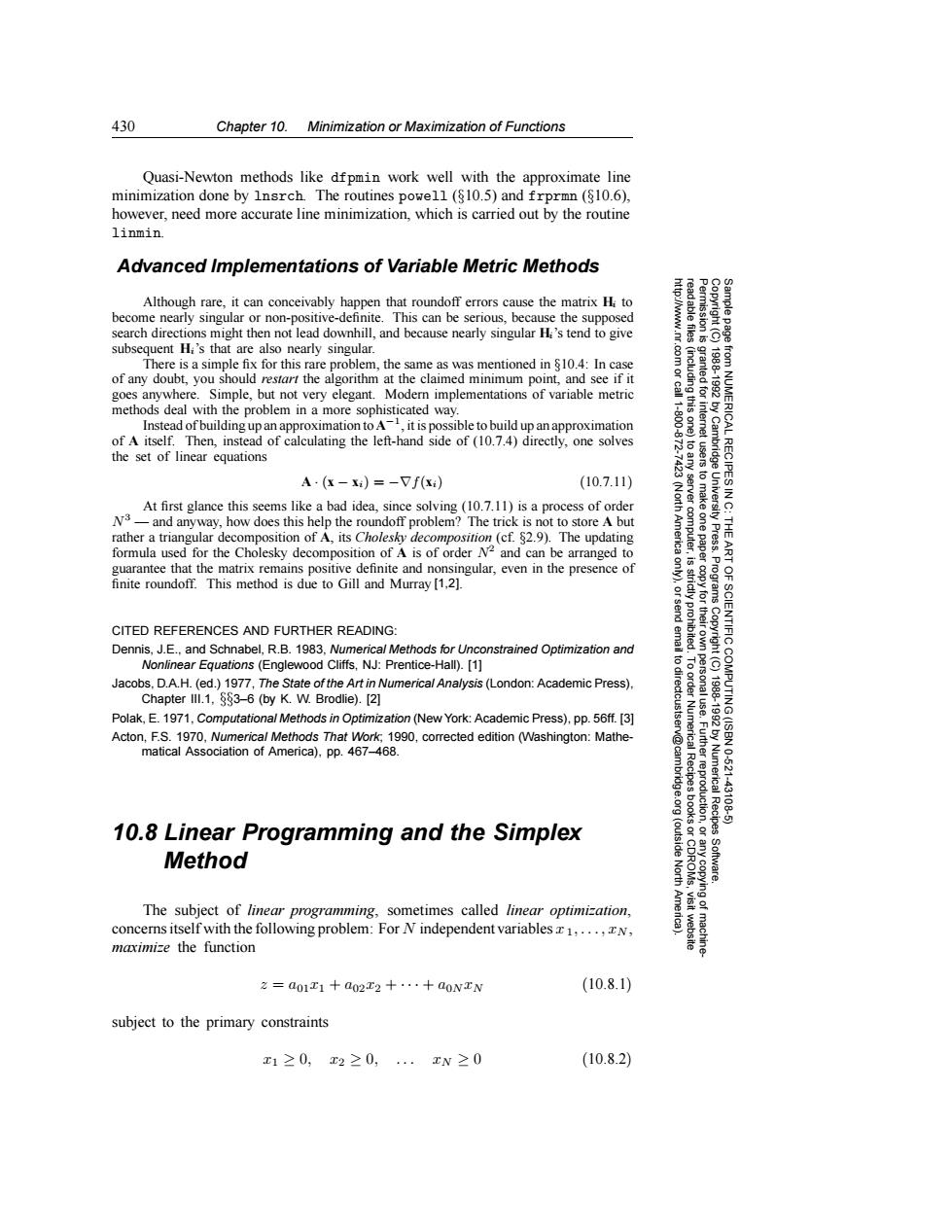正在加载图片...

430 Chapter 10.Minimization or Maximization of Functions Quasi-Newton methods like dfpmin work well with the approximate line minimization done by Insrch.The routines powell(810.5)and frprmn($10.6), however,need more accurate line minimization,which is carried out by the routine linmin Advanced Implementations of Variable Metric Methods Although rare,it can conceivably happen that roundoff errors cause the matrix Hi to become nearly singular or non-positive-definite.This can be serious,because the supposed search directions might then not lead downhill,and because nearly singular Hi's tend to give subsequent Hi's that are also nearly singular. There is a simple fix for this rare problem,the same as was mentioned in 810.4:In case of any doubt,you should restart the algorithm at the claimed minimum point,and see if it goes anywhere.Simple,but not very elegant.Modern implementations of variable metric methods deal with the problem in a more sophisticated way. Instead of building up an approximation to A,it is possible to build up an approximation of A itself.Then,instead of calculating the left-hand side of (10.7.4)directly,one solves the set of linear equations 华 A·(x-x)=-7fx) (10.7.11) 2 At first glance this seems like a bad idea,since solving (10.7.11)is a process of order N3-and anyway,how does this help the roundoff problem?The trick is not to store A but rather a triangular decomposition of A,its Cholesky decomposition (cf.$2.9).The updating Press. formula used for the Cholesky decomposition of A is of order N2 and can be arranged to guarantee that the matrix remains positive definite and nonsingular,even in the presence of finite roundoff.This method is due to Gill and Murray [1,2]. CITED REFERENCES AND FURTHER READING: OF SCIENTIFIC( Dennis,J.E.,and Schnabel,R.B.1983.Numerica/Methods for Unconstrained Optimization and Nonlinear Equations (Englewood Cliffs,NJ:Prentice-Hall).[1] 6 Jacobs,D.A.H.(ed.)1977,The State of the Art in Numerical Analysis(London:Academic Press), Chapter Ill.1,883-6 (by K.W.Brodlie).[2] Polak,E.1971,Computational Methods in Optimization (New York:Academic Press),pp.56ff.[3] 最 Acton,F.S.1970,Numerica/Methods That Work,1990,corrected edition (Washington:Mathe- matical Association of America),pp.467-468. Fuunrgroirion Numerical Recipes 10-621 43106 10.8 Linear Programming and the Simplex (outside Method North Software. The subject of linear programming,sometimes called linear optimization, Ame concerns itself with the following problem:For N independent variables1,...,N, maximize the function 2=a01E1+a02r2+···+a0NxN (10.8.1) subject to the primary constraints x1≥0,2≥0,.xN≥0 (10.8.2)430 Chapter 10. Minimization or Maximization of Functions Permission is granted for internet users to make one paper copy for their own personal use. Further reproduction, or any copyin Copyright (C) 1988-1992 by Cambridge University Press. Programs Copyright (C) 1988-1992 by Numerical Recipes Software. Sample page from NUMERICAL RECIPES IN C: THE ART OF SCIENTIFIC COMPUTING (ISBN 0-521-43108-5) g of machinereadable files (including this one) to any server computer, is strictly prohibited. To order Numerical Recipes books or CDROMs, visit website http://www.nr.com or call 1-800-872-7423 (North America only), or send email to directcustserv@cambridge.org (outside North America). Quasi-Newton methods like dfpmin work well with the approximate line minimization done by lnsrch. The routines powell (§10.5) and frprmn (§10.6), however, need more accurate line minimization, which is carried out by the routine linmin. Advanced Implementations of Variable Metric Methods Although rare, it can conceivably happen that roundoff errors cause the matrix Hi to become nearly singular or non-positive-definite. This can be serious, because the supposed search directions might then not lead downhill, and because nearly singular Hi’s tend to give subsequent Hi’s that are also nearly singular. There is a simple fix for this rare problem, the same as was mentioned in §10.4: In case of any doubt, you should restart the algorithm at the claimed minimum point, and see if it goes anywhere. Simple, but not very elegant. Modern implementations of variable metric methods deal with the problem in a more sophisticated way. Instead of building up an approximation to A−1, it is possible to build up an approximation of A itself. Then, instead of calculating the left-hand side of (10.7.4) directly, one solves the set of linear equations A · (x − xi) = −∇f(xi) (10.7.11) At first glance this seems like a bad idea, since solving (10.7.11) is a process of order N3 — and anyway, how does this help the roundoff problem? The trick is not to store A but rather a triangular decomposition of A, its Cholesky decomposition (cf. §2.9). The updating formula used for the Cholesky decomposition of A is of order N2 and can be arranged to guarantee that the matrix remains positive definite and nonsingular, even in the presence of finite roundoff. This method is due to Gill and Murray [1,2]. CITED REFERENCES AND FURTHER READING: Dennis, J.E., and Schnabel, R.B. 1983, Numerical Methods for Unconstrained Optimization and Nonlinear Equations (Englewood Cliffs, NJ: Prentice-Hall). [1] Jacobs, D.A.H. (ed.) 1977, The State of the Art in Numerical Analysis (London: Academic Press), Chapter III.1, §§3–6 (by K. W. Brodlie). [2] Polak, E. 1971, Computational Methods in Optimization (New York: Academic Press), pp. 56ff. [3] Acton, F.S. 1970, Numerical Methods That Work; 1990, corrected edition (Washington: Mathematical Association of America), pp. 467–468. 10.8 Linear Programming and the Simplex Method The subject of linear programming, sometimes called linear optimization, concerns itself with the following problem: For N independent variables x1,...,xN , maximize the function z = a01x1 + a02x2 + ··· + a0N xN (10.8.1) subject to the primary constraints x1 ≥ 0, x2 ≥ 0, ... xN ≥ 0 (10.8.2)